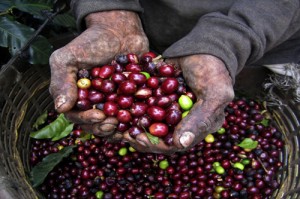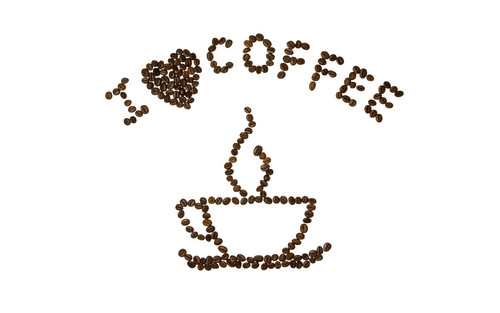Simran Sethi, Environmental Messenger, is part of the barrage of the Wheeler Centre‘s 2015 questions to Melbourne. She gives a talk entitled ‘Endangered Pleasures; the slow loss of food we love’ on March the first. Simran is a petite woman with shining black hair that swings around her like a mobile halo. Her generous smile is a brilliant white. She gestures with her hands, moulding meaning into the air in front of her, giving, exuding, impressing influence into her audience.
The focus of her speech, as best suits cafe-cultured Melbourne, is coffee. A few years ago, on a research trip to Rome, she was side tracked by a novel concept (to her). She’d been writing a book about seeds when she discovered scientists were actually concerned with teetering bioagrodiversity. Remember the beginning of that very scientific film Interstellar? Where that geeky science boffin, Michael Caine, points out the blighted corn? Not so fictional after all.
It seems many of our staple food crops are at risk of extinction. Wheat. Cows. Chocolate. And coffee. (Simran didn’t mention bees.) Of course we know the threats. Loss of habitat, pollution, climate change, disease …
Only 30% of all species are used by humans. Basically we don’t care what happens to stuff we can’t eat, drink or wear. If it doesn’t act like a pest, we ignore it. If it’s a crop we choose the best of the best, breed it up and maybe add some spicy cells to a test tube to improve it further. Then we only farm that one species. All across the world. The same species of banana. And when that one species falls prey to one disease? All gone.
Where the scientists see genetic erosion Simran sees cultural erosion. She became animated as she described her fantastic global research project to understand the web of coffee making. To seek the hands that make the coffee.
From the calloused farmer to the tattooed barista, it is the sweat and toil of humans that intrigues Simran. Her coffee guru comes from Seven Seeds, a Melbourne coffee roasting cafe, educator and specialist. His coaching leads her to understand the taste of coffee for the first time. Now more than just wet brown stuff, along with flavours of lemon and hints of peach, she can discern the soil and the weather of Ethopia, or Columbia perhaps. The flavour of her coffee is mixed with farmers’ sweat and the swirl of dryers’ rakes. There’s packers, drivers, container loaders, ship crew, unloaders, more drivers, roasters, grinders, and the hiss of steam at the end. All endangered.
Simran pointed out that scientists use a combination of strategies to save plant species from extinction. There’s ex-situ conservation such as seed banks (struggling for funding in the main). There’s in-situ conservation such as leaving the plant to grow in the wild or at a farm. And there’s in-vivo conservation where humans eat it, drink it and keep it alive because humans like it. Love it.
If we all learn more about our foodstuff, Simran says, we will give thanks. She believes we can save our favourite plants by our very dependence. If we consider our coffee, we will save our coffee. Her reply to the question about an individual’s ability to affect the food chain was that we should all be kind, learn the provinance of our produce and revalue what is important. If only that was all it took, Simran.
The final question about population caused her to bridle a little. As an Indian she did not think that millions of brown people in subsistence living standards damaged the planet as much as the millions of fat people living in America, consuming fossil fuels as though they are going out of style. (Which they are.) According to Simran, consumption, not population, is the real problem.
Simran is an extremely highly regarded academic, journalist and eco-activist. She is working hard to activate the audience’s ‘green brain’, the part of our brains that imagines the future, that might act to save our planet if it cares about something. I’m sure her book about Bread, Wine and Chocolate (due Nov 2015) will be very well received and completely ineffective. People in the Fair Trade and Slow Food movements have been saying these things, DOING these things, for decades. In my own files I have a report dated 1986 by the World Wildlife Foundation called The Wild Supermarket: the importance of biological diversity to food security.
I can’t believe that anything Simran can add, (even if she is The Environmental Messenger and an expert on engagement) will cause millions of people to stop buying cheap food from Woolies and rush to their nearest farmer’s market. I fear those under the verdant green plastic globule that is RMIT’s entrance to Storey Hall Lecture Theatre on Sunday are already converted.
If only Simran wasn’t busy flying all over the world taking photos of hands with her great big carbon footprint. Just because it’s self-confessed doesn’t make it right. Many activists now use Skype to deliver just such communications. (People such as Professor Mary Wood, the lawyer fighting for Nature’s rights.)
Simran’s pat reply to the inevitable population question stems from her heritage and from her heart, I fear, rather than her head. Any parent, anywhere on this beleaguered planet, will raise up their children as high as they can. It is in our genes. If they are in a tent in Somalia, a slum in Mumbai or the Dakota building overlooking Central Park, that parent will try to ensure their child can afford a fridge and a car and a mortgage. And a nice secure share portfolio with an eye to growth. Consumption is of course part of the problem. Human’s need to improve their lot drives it. Human greed drives the use of fossil fuels, habitat loss, climate change …
And, as no there is no effective action to slow any of it, then the species of greatest risk of disappearing is not coffee, or bananas or wheat.
It’s humans.
And you’d think people would care enough about them, wouldn’t you.





